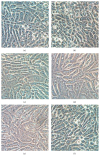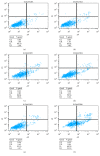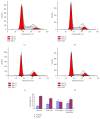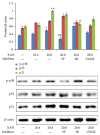Regulation of MAPKs Signaling Contributes to the Growth Inhibition of 1,7-Dihydroxy-3,4-dimethoxyxanthone on Multidrug Resistance A549/Taxol Cells
- PMID: 27403196
- PMCID: PMC4925979
- DOI: 10.1155/2016/2018704
Regulation of MAPKs Signaling Contributes to the Growth Inhibition of 1,7-Dihydroxy-3,4-dimethoxyxanthone on Multidrug Resistance A549/Taxol Cells
Abstract
1,7-Dihydroxy-3,4-dimethoxyxanthone (XAN) is a bioactive compound isolated from Securidaca inappendiculata Hassk. and validated with antiproliferative activities on a panel of cancer cell lines. This study was designed to investigate its growth inhibitory effects on multidrug resistance (MDR) non-small cell lung carcinoma (NSCLC) cell line A549/Taxol and explore the possible linkage between modulation of MAPKs and the bioactivities. Its growth inhibitory potency on the cells was estimated by MTT assay, and flow cytometric analysis was employed to investigate its potential cell cycle arrest and proapoptosis effects. Expressions of hallmark proteins were assessed by Western-Blot method. The results showed A549/Taxol cells were sensitive to XAN. XAN inhibited the proliferation of A549/Taxol cells in the time and concentration dependent manners. It acted as a potent inducer of apoptosis and cell cycle arrest in the cells. Western-Blot investigation validated the proapoptosis and cell cycle arrest activities of XAN and the potential of MDR reversion. Upregulation of p38 by XAN, which accounted for the cell cycle arrest at G2 phase, and the downregulation of ERK associated with the proapoptosis activity were also revealed. Further analysis found p53 may be the central role mediated the bioactivities of MAPKs in A549/Taxol cells. Based on these evidences, a conclusion has been deduced that XAN could be a potential agent for MDR NSCLC therapy targeting specifically MAPKs.
Figures






Similar articles
-
Selective modulation of MAPKs contribute to the anti-proliferative and anti-inflammatory activities of 1,7-dihydroxy-3,4-dimethoxyxanthone in rheumatoid arthritis-derived fibroblast-like synoviocyte MH7A cells.J Ethnopharmacol. 2015 Jun 20;168:248-54. doi: 10.1016/j.jep.2015.03.069. Epub 2015 Apr 8. J Ethnopharmacol. 2015. PMID: 25862966
-
Reactive oxygen species mediated NF-κB/p38 feedback loop implicated in proliferation inhibition of HFLS-RA cells induced by 1,7-dihydroxy-3,4-dimethoxyxanthone.Biomed Pharmacother. 2017 Oct;94:1002-1009. doi: 10.1016/j.biopha.2017.07.164. Epub 2017 Aug 12. Biomed Pharmacother. 2017. PMID: 28810523
-
Triptolide exerts pro-apoptotic and cell cycle arrest activity on drug-resistant human lung cancer A549/Taxol cells via modulation of MAPK and PI3K/Akt signaling pathways.Oncol Lett. 2016 Nov;12(5):3586-3590. doi: 10.3892/ol.2016.5099. Epub 2016 Sep 7. Oncol Lett. 2016. PMID: 27900040 Free PMC article.
-
MAY, a novel tubulin inhibitor, induces cell apoptosis in A549 and A549/Taxol cells and inhibits epithelial-mesenchymal transition in A549/Taxol cells.Chem Biol Interact. 2020 May 25;323:109074. doi: 10.1016/j.cbi.2020.109074. Epub 2020 Mar 23. Chem Biol Interact. 2020. PMID: 32217108
-
BZML, a novel colchicine binding site inhibitor, overcomes multidrug resistance in A549/Taxol cells by inhibiting P-gp function and inducing mitotic catastrophe.Cancer Lett. 2017 Aug 28;402:81-92. doi: 10.1016/j.canlet.2017.05.016. Epub 2017 May 30. Cancer Lett. 2017. PMID: 28576750
Cited by
-
Reversal effect of adenovirus-mediated human interleukin 24 transfection on the cisplatin resistance of A549/DDP lung cancer cells.Oncol Rep. 2017 Nov;38(5):2843-2851. doi: 10.3892/or.2017.6002. Epub 2017 Sep 26. Oncol Rep. 2017. PMID: 29048638 Free PMC article.
-
Role of miR-584-5p in Lipopolysaccharide-Stimulated Human Bronchial Epithelial Cell Inflammation and Apoptosis.Evid Based Complement Alternat Med. 2022 Apr 11;2022:2408682. doi: 10.1155/2022/2408682. eCollection 2022. Evid Based Complement Alternat Med. 2022. Retraction in: Evid Based Complement Alternat Med. 2023 Dec 6;2023:9763403. doi: 10.1155/2023/9763403. PMID: 35449817 Free PMC article. Retracted.
-
The use of African medicinal plants in cancer management.Front Pharmacol. 2023 Feb 14;14:1122388. doi: 10.3389/fphar.2023.1122388. eCollection 2023. Front Pharmacol. 2023. PMID: 36865913 Free PMC article. Review.
-
Anti-inflammatory effects of 1,7-dihydroxy-3,4-dimethoxyxanthone through inhibition of M1-phenotype macrophages via arginine/mitochondrial axis.Immunol Res. 2024 Dec;72(6):1404-1416. doi: 10.1007/s12026-024-09538-w. Epub 2024 Sep 30. Immunol Res. 2024. PMID: 39349673
-
Activities of Some Medicinal Plants on the Proliferation and Invasion of Brain Tumor Cell Lines.Adv Pharmacol Pharm Sci. 2020 Aug 27;2020:3626879. doi: 10.1155/2020/3626879. eCollection 2020. Adv Pharmacol Pharm Sci. 2020. PMID: 32908971 Free PMC article.
References
-
- Li Y. W. Studies on the anti-inflammatory, immune and analgesic effects and their mechanisms of WWT [M.S. thesis] Guangxi University of Medicine; 2005.
-
- Zuo J., Xia Y., Li X., Zhen O. Y., Chen J.-W. Selective modulation of MAPKs contribute to the anti-proliferative and anti-inflammatory activities of 1,7-dihydroxy-3,4-dimethoxyxanthone in rheumatoid arthritis-derived fibroblast-like synoviocyte MH7A cells. Journal of Ethnopharmacology. 2015;168:248–254. doi: 10.1016/j.jep.2015.03.069. - DOI - PubMed
-
- Zuo J., Mao K.-J., Yuan F., Li X., Chen J.-W. Xanthones with anti-tumor activity isolated from Securidaca inappendiculata . Medicinal Chemistry Research. 2014;23(11):4865–4871. doi: 10.1007/s00044-014-1051-8. - DOI
LinkOut - more resources
Full Text Sources
Other Literature Sources
Research Materials
Miscellaneous

